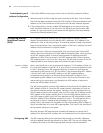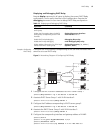
52 CHAPTER 4: NETWORK PROTOCOL OPERATION
Troubleshooting an IP
Address Configuration
If the Switch 8800 cannot ping a certain host on the LAN, proceed as follows:
1 Determine which VLAN includes the port connected to the host. Check whether
the VLAN has been configured with the VLAN interface. Determine whether the IP
address of the VLAN interface and the host are on the same network segment.
2 If the configuration is correct, enable ARP debugging on the switch from user
level, and check whether or not the switch can correctly send and receive ARP
packets. If it can only send but not receive the ARP packets, there are probably
errors at the Ethernet physical layer.
Configuring Address
Resolution Protocol
(ARP)
An IP address cannot be directly used for communication between network
devices, because devices can only identify MAC addresses. An IP address is the
address of a host at the network layer. To send data packets through the network
layer to the destination host, the physical address of the host is required. So the IP
address must be resolved to a physical address.
When two hosts in Ethernet communicate, they must know each other’s MAC
address. Every host maintains an IP-MAC address translation table, which is known
as the ARP mapping table. A series of maps between IP addresses and MAC
addresses of other hosts are stored in the ARP mapping table. When a dynamic
ARP mapping entry is not in use for a long time, the host will remove it from the
mapping table to save memory space and shorten the search interval.
Example: IP Address
Resolution
Host A and Host B are on the same network segment. The IP address of Host A is
IP_A and the IP address of Host B is IP_B. Host A wants to transmit packets to Host
B. Host A checks its own ARP mapping table first to make sure that there are
corresponding ARP entries of IP_B in the table. If the corresponding MAC address
is found, Host A will use the MAC address in the ARP mapping table to
encapsulate the IP packet in an Ethernet frame and send it to Host B. If the
corresponding MAC address is not found, Host A will store the IP packet in the
queue waiting for transmission, and broadcast an ARP request to attempt to
resolve the MAX address of Host B.
The ARP request packet contains the IP address of Host B and the IP address and
MAC address of Host A. Since the ARP request packet is broadcast, all hosts on
the network segment receive the request. However, only the requested host (i.e.,
Host B) needs to process the request. Host B will first store the IP address and the
MAC address of the request sender (Host A) from the ARP request packet in its
own ARP mapping table. Host B will then generate an ARP reply packet and add
the MAC address of Host B before sending it to Host A. The reply packet will be
sent directly to Host A instead of being broadcast. Upon receiving the reply
packet, Host A will extract the IP address and the corresponding MAC address of
Host B and add them to its own ARP mapping table. Then Host A will send Host B
all the packets standing in the queue.
Normally, dynamic ARP executes and automatically attempts to resolve the IP
address to an Ethernet MAC address with no intervention from the administrator.
Configuring ARP The ARP mapping table can be maintained dynamically or manually. Addresses
that are mapped manually are referred to as static ARP. The user can display, add,
or delete the entries in the ARP mapping table through manual commands.


















